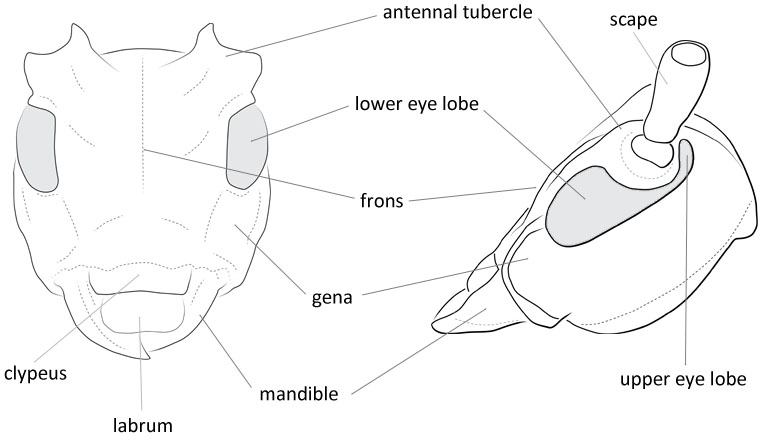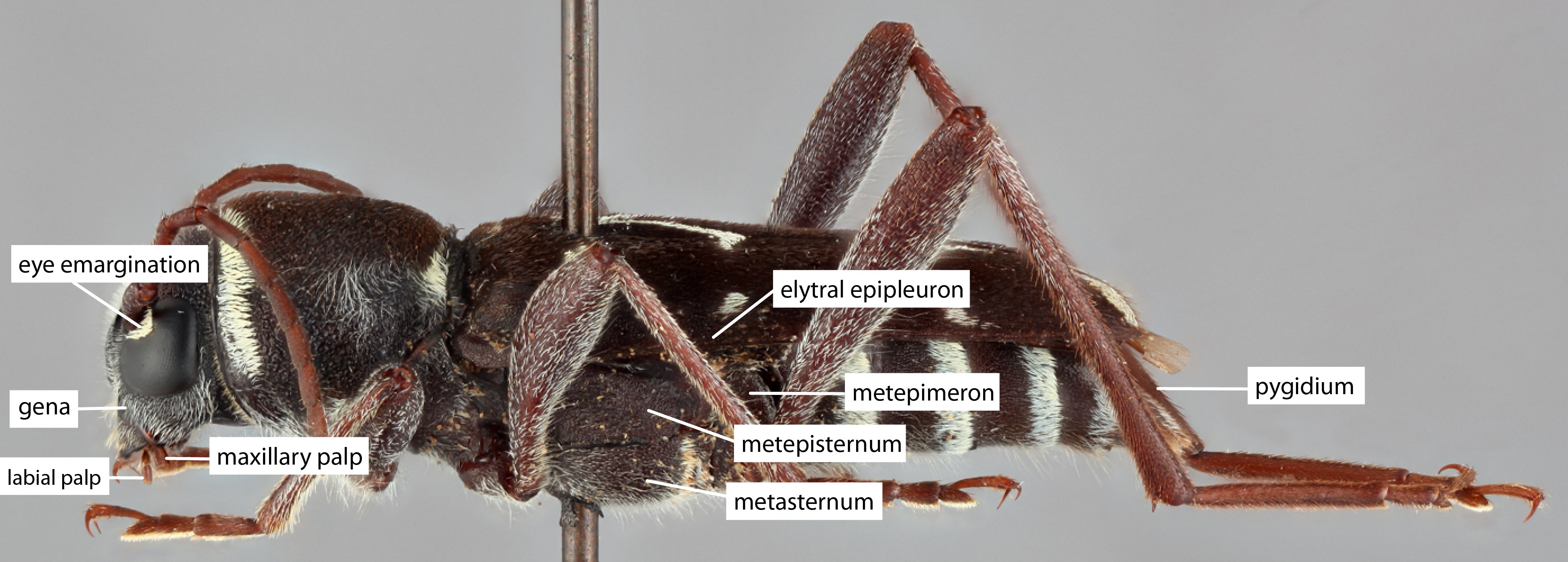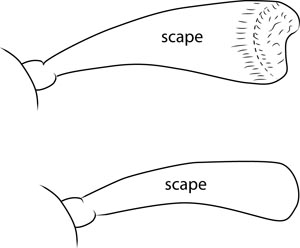Monochamus grandis Waterhouse, 1881: 431
Length: 38–44 mm.
Elytral length:width ratio: length > 2x width.
Face: shape wide rectangle; genagena:
the part of the cranium on each side below the eye length shorter than lower eye lobeeye lobe:
length shorter than lower eye lobeeye lobe:
used to refer to the upper or lower portion when the eye is emarginate or separated or subequal to lower eye lobeeye lobe:
or subequal to lower eye lobeeye lobe:
used to refer to the upper or lower portion when the eye is emarginate or separated .
.
Pronotum: dense setaeseta:
a sclerotized hair-like projection of the cuticle
on dorsum of lateral spines present; maculaemacula:
a spot or mark
on pronotal disk: 2–4 dots present or absent; posteromedial tubercletubercle:
a small knoblike or rounded protuberance
present; lateral erect setaeseta:
a sclerotized hair-like projection of the cuticle
: only present posterior to spinespine:
a protuberance with an acute (sharp) distal end
.
Scutellum: dense and complete pubescence.
Elytra: elytral integument color black; elytral maculaemacula:
a spot or mark
: pubescence forming horizontal band(s) or sparse ash-like pubescence; elytral sutural apexapex:
end of any structure distad to the base
dentate; elevation in basal third followed by impression absent; basal granulation dense and coarse; middle to apical punctationpunctation:
pits or depression of variable size in cuticle
fine or nearly impunctate.
Antennal length (female): 2–3.5 segments beyond elytral apexapex:
end of any structure distad to the base
.
Aedeagus: paramereparamere:
A pair of finger-like structures that are located where the male genitalia exits the abdomen.
mediobasal tooth present; apical tip (ventral view) truncatetruncate:
cut off squarely at the tip
; terminal segment absent; scleritesclerite:
any hardened plate of the body wall bounded by membrane or sutures; sometimes found floating in the internal sac of male genitalia
in internal sac: contains a scleritesclerite:
any hardened plate of the body wall bounded by membrane or sutures; sometimes found floating in the internal sac of male genitalia
in internal sac.
Close to Monochamus urussovii (Fisch.). Well distinguished from it by dense yellow or grayish pilose spot on pronotumpronotum:
the upper and dorsal part of the prothorax
at basebase:
the part of any appendage or structure that is nearest the body
of lateral tubercles, narrow longitudinal glabrousglabrous:
smooth, devoid of pubescence; devoid of any sculpturing
band medially on shield, and absence of whitish tinge on hind clivus of elytraelytron:
the leathery forewing of beetles, serving as a covering for the hind wings, commonly meeting opposite elytron in a straight line down the middle of the dorsum in repose
. Body large, elongateelongate:
much longer than wide
. Head with coarse striatestriate:
marked with parallel, fine, longitudinal, impressed lines or furrows
uneven punctationpunctation:
pits or depression of variable size in cuticle
, medially with narrow longitudinal groove, near basebase:
the part of any appendage or structure that is nearest the body
of antennaeantenna:
in larval and adult insects, paired segmented appendages, borne one on each side of the head, functioning as sense organs and bearing a large number of sensilla
with highly (male) or slightly spiniform, extended tubercletubercle:
a small knoblike or rounded protuberance
. Eyes broadly emarginateemarginate:
notched at the margin , upper ocular lobelobe:
, upper ocular lobelobe:
a rounded projection or protuberence
barely broader than lacertus between it and lower lobelobe:
a rounded projection or protuberence
. maculaemacula:
a spot or mark
:.3 (male) or 1.1 (female) times longer than body, extending beyond apexapex:
end of any structure distad to the base
of elytraelytron:
the leathery forewing of beetles, serving as a covering for the hind wings, commonly meeting opposite elytron in a straight line down the middle of the dorsum in repose
by 5th (male) or 10th (female) segment. First antennal segment with compact striatestriate:
marked with parallel, fine, longitudinal, impressed lines or furrows
punctationpunctation:
pits or depression of variable size in cuticle
, apically on outer side with semicircular area (cicatrixcicatrix:
a scar; a scar-like structure ) demarcated by sharp ridge; beginning with 3rd segment with bold granular (male) or minute (female) punctationpunctation:
) demarcated by sharp ridge; beginning with 3rd segment with bold granular (male) or minute (female) punctationpunctation:
pits or depression of variable size in cuticle
; segments basally with bright pilose ringlets (female) or without them (male). Pronotumpronotum:
the upper and dorsal part of the prothorax
in basal width not less (female) or slightly less (male) than in length, near anterior margin with broad, near posterior margin with narrow distinct flange, disk convex, medially in front of posterior flange with more (female) or less (male) distinct tubercular prominence, laterally with acute spiniform tubercletubercle:
a small knoblike or rounded protuberance
, with compact, not very bold punctationpunctation:
pits or depression of variable size in cuticle
, on flanges without transversetransverse:
broader than long
striae, with minute grayish or somewhat rusty adherent hairs forming one large spot near basebase:
the part of any appendage or structure that is nearest the body
(posteriorly) of each lateral tubercletubercle:
a small knoblike or rounded protuberance
; sometimes two additional round spotlets occur on disk near anterior flange, pronotal shield insignificantly elongateelongate:
much longer than wide
, basal width not more or even less than length, with dense adherent yellowish hairs, medially with narrow glabrousglabrous:
smooth, devoid of pubescence; devoid of any sculpturing
longitudinal band, which is lustrous due to more rarefied pubescence here. ElytraElytron:
the leathery forewing of beetles, serving as a covering for the hind wings, commonly meeting opposite elytron in a straight line down the middle of the dorsum in repose
convex, elongateelongate:
much longer than wide
, without transversetransverse:
broader than long
notch, parallel-sided (female) or slightly tapering toward apexapex:
end of any structure distad to the base
(male), apically jointly rounded, with very acute (straight, male) or slightly rounded (female) inner angle, with barely projecting humeral tubercletubercle:
a small knoblike or rounded protuberance
, in anterior fourth with bold, in remaining part evanescent, barely perceptible punctationpunctation:
pits or depression of variable size in cuticle
, with very minute, compact adherent gray or yellowish hairs forming medially and in front of hind clivus barely perceptible, slanting bands extending from suturesuture:
groove marking the line of fusion of two formerly distinct plates; the line of junction of elytra
laterad. Sometimes these bands are absent, sometimes individual grayish specks present, or elytraelytron:
the leathery forewing of beetles, serving as a covering for the hind wings, commonly meeting opposite elytron in a straight line down the middle of the dorsum in repose
entirely black, without specks. Legs long, femora uniformly thickened, foretibiae in males somewhat longer than midtibiae, foretarsi broad, laterally with long dense black hairs; in females foretibiae not longer than midtibiae, foretarsi not enlarged, laterally without long black hairs. Body ventrally with tender adherent hairs forming spot-like cluster near posterior angles of metasternum and laterally on prosternum, Sternite V in females broadly emarginateemarginate:
notched at the margin apically, with long dense black hairs forming here lateral brush-like cluster, in males rounded, without long black hairs. Body length 38–44 mm. (Cherepanov 1990Cherepanov 1990:
apically, with long dense black hairs forming here lateral brush-like cluster, in males rounded, without long black hairs. Body length 38–44 mm. (Cherepanov 1990Cherepanov 1990:
Cherepanov AI. 1990. Cerambycidae of Northern Asia, Vol. 3. Lamiinae, Part I. Oxonian Press, New Delhi 4: i–xiii + 1–300, 120 figs.)
M. sartor
The massive size, dense pubescence on the pronotal spines, prominent tubercletubercle:
a small knoblike or rounded protuberance
on the pronotumpronotum:
the upper and dorsal part of the prothorax
, and no elevated area at the basebase:
the part of any appendage or structure that is nearest the body
of the elytraelytron:
the leathery forewing of beetles, serving as a covering for the hind wings, commonly meeting opposite elytron in a straight line down the middle of the dorsum in repose
distinguish this species.
Japan, Sakhalin
Abies, Larix, Pinus, Picea, Tsuga (Titan DatabaseTitan Database:
Tavakilian GL and Chevillotte H. 2022. Titan: base de données internationales sur les Cerambycidae ou Longicornes. Version 3.0. Available from: http://titan.gbif.fr/ last accessed September 2022)
N/A